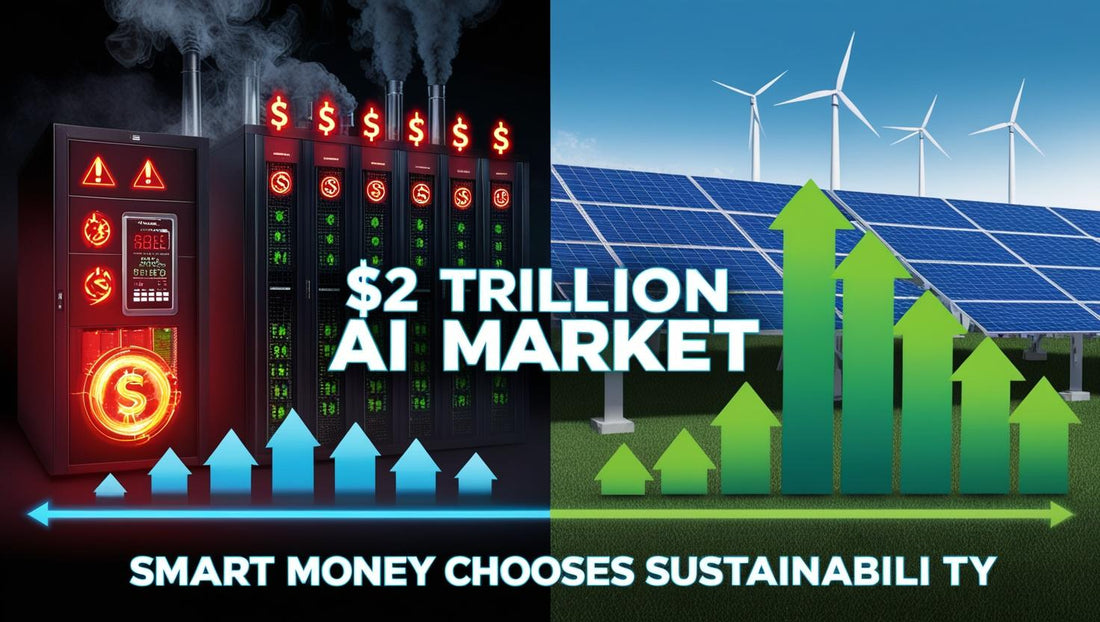
The $2 Trillion AI Bubble: Why Smart Money is Betting on Sustainable Tech Infrastructure
The artificial intelligence sector has ballooned to unprecedented valuations, with some analysts pegging the total market at over $2 trillion. Yet beneath the glossy headlines and soaring stock prices, a quiet revolution is taking place. The smartest investors aren't just throwing money at any AI company—they're strategically positioning themselves in sustainable tech infrastructure that can weather both market volatility and literal storms.
The Great AI Investment Paradox
Walk into any Silicon Valley boardroom today, and you'll hear the same refrain: "AI is the future." Companies are hemorrhaging cash to build ever-larger language models, racing to create the next ChatGPT or Claude. But here's what the venture capital crowd doesn't want you to know—most of these investments are built on infrastructure that's fundamentally unsustainable.
The numbers tell a sobering story. Training a single large language model can consume as much electricity as 1,000 homes use in a year. When you multiply that across thousands of companies all racing to build the next breakthrough, you're looking at energy consumption that rivals entire countries. And that's before we even talk about the cooling costs, the server replacements, and the mounting pressure from regulators who are finally waking up to AI's environmental impact.

Why Traditional AI Infrastructure is a House of Cards
The current AI boom reminds seasoned investors of the dot-com bubble of the late 1990s. Everyone was convinced the internet would change everything—and they were right. But most of the companies that attracted the biggest investments during that era are now footnotes in tech history. The survivors were those who built sustainable, scalable infrastructure.
Today's AI companies face similar challenges, but with an added twist: they're building on infrastructure that's increasingly incompatible with our climate reality. Data centers are already responsible for about 1% of global electricity consumption, and that number is expected to triple by 2030. Meanwhile, extreme weather events are becoming more frequent and more severe, threatening the very facilities that power our digital economy.
Smart investors are recognizing that the companies most likely to survive and thrive are those thinking beyond the next funding round. They're investing in AI infrastructure that's designed to be resilient, efficient, and sustainable from the ground up.

The New Investment Thesis: Climate-Smart AI
Forward-thinking investors are shifting their focus from flashy AI applications to the unglamorous but critical infrastructure layer. This isn't just about being environmentally responsible—it's about risk management and long-term profitability.
Consider the math: A data center that reduces its energy consumption by 30% doesn't just cut its carbon footprint—it slashes operational costs by millions of dollars annually. A facility designed to withstand extreme weather events avoids costly downtime that can bankrupt AI startups burning through cash at unprecedented rates.

The investment opportunities in this space are vast and largely untapped. From novel cooling technologies that use 90% less water than traditional systems, to AI chips designed specifically for energy efficiency, to distributed computing architectures that spread risk across multiple geographic regions—the infrastructure revolution is just beginning.
Following the Smart Money Trail
Some of the world's most successful investors are already positioning themselves for this shift. They're looking beyond the AI companies making headlines and focusing on the picks-and-shovels businesses that will enable sustainable AI at scale.
These investors understand that regulation is coming. The European Union's AI Act is just the beginning. As governments worldwide grapple with AI's environmental impact, companies with sustainable infrastructure will have a massive competitive advantage. Those still relying on energy-hungry, climate-vulnerable systems will face increasing regulatory pressure and escalating costs.

The smart money is also recognizing that sustainability isn't just about compliance—it's about resilience. Climate change isn't a future threat; it's a present reality affecting business operations today. The AI companies that build with this reality in mind will be the ones still standing when the market inevitably corrects.
The Infrastructure Investment Opportunity
For investors looking to capitalize on the AI boom without getting caught in the bubble, the infrastructure play offers compelling advantages. Unlike AI applications that may become obsolete as technology evolves, robust infrastructure becomes more valuable over time. It's the digital equivalent of investing in railroads during the industrial revolution rather than betting on individual railroad companies.
The key is identifying infrastructure solutions that solve multiple problems simultaneously. The best investments in this space don't just address climate concerns—they also improve performance, reduce costs, and enhance reliability. These are the solutions that will attract customers regardless of their environmental motivations.
Building for the Long Game
The AI revolution is real, but it's going to look very different from what most people expect. The companies that survive and thrive will be those that build sustainable, resilient infrastructure from day one. They'll be the ones that recognize climate resilience isn't just an environmental nice-to-have—it's a business imperative.

For investors, this creates an unprecedented opportunity. While everyone else is chasing the latest AI unicorn, smart money is quietly backing the infrastructure companies that will power the next generation of artificial intelligence. These investments may not make headlines today, but they're positioning themselves to capture value for decades to come.
The $2 trillion AI market is real, but it's built on shaky foundations. The winners will be those who recognize that sustainable infrastructure isn't just better for the planet—it's better for business. And in a world where extreme weather events can shut down entire data centers and regulatory pressure is mounting, that might be the smartest bet of all.
The intersection of AI investment and climate resilience represents one of the most significant opportunities in today's market. Understanding how to evaluate and implement climate-resilient AI infrastructure requires deep technical knowledge and strategic foresight—expertise that can make the difference between sustainable success and costly failure.
